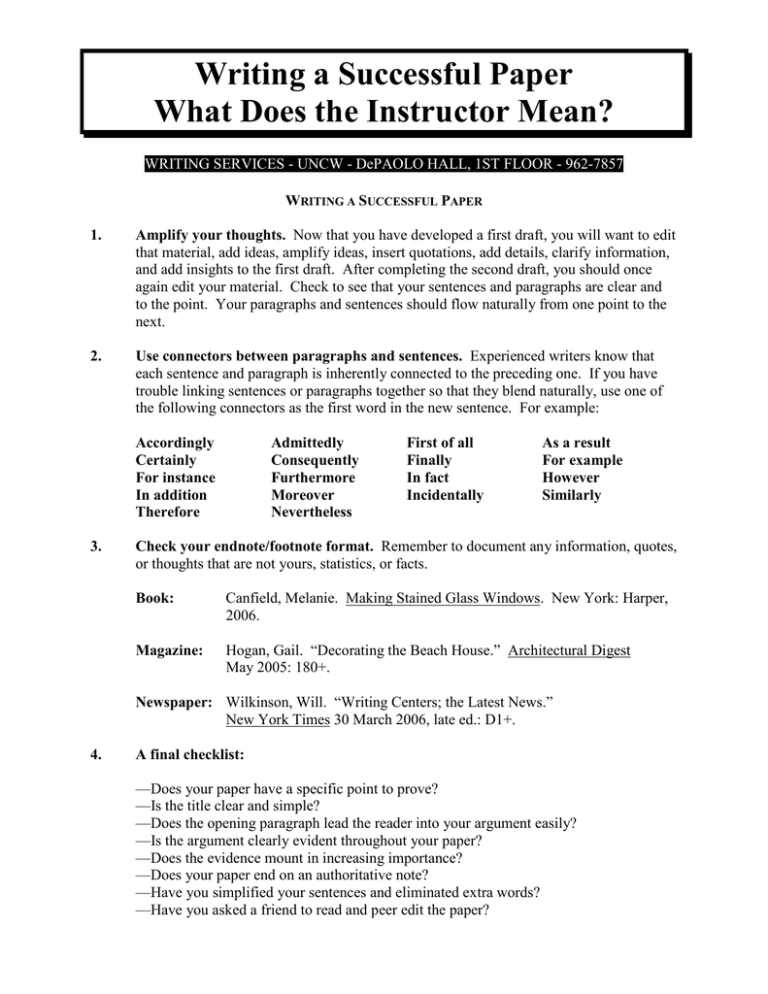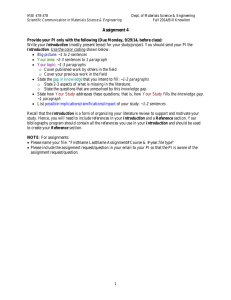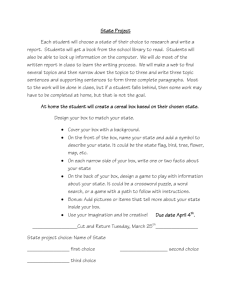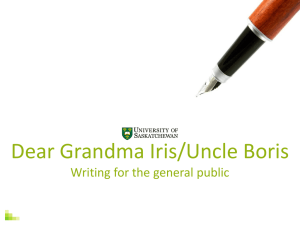Writing a Successful Paper What Does the Instructor Mean?
advertisement

Writing a Successful Paper What Does the Instructor Mean? WRITING SERVICES - UNCW - DePAOLO HALL, 1ST FLOOR - 962-7857 WRITING A SUCCESSFUL PAPER 1. Amplify your thoughts. Now that you have developed a first draft, you will want to edit that material, add ideas, amplify ideas, insert quotations, add details, clarify information, and add insights to the first draft. After completing the second draft, you should once again edit your material. Check to see that your sentences and paragraphs are clear and to the point. Your paragraphs and sentences should flow naturally from one point to the next. 2. Use connectors between paragraphs and sentences. Experienced writers know that each sentence and paragraph is inherently connected to the preceding one. If you have trouble linking sentences or paragraphs together so that they blend naturally, use one of the following connectors as the first word in the new sentence. For example: Accordingly Certainly For instance In addition Therefore 3. Admittedly Consequently Furthermore Moreover Nevertheless First of all Finally In fact Incidentally As a result For example However Similarly Check your endnote/footnote format. Remember to document any information, quotes, or thoughts that are not yours, statistics, or facts. Book: Canfield, Melanie. Making Stained Glass Windows. New York: Harper, 2006. Magazine: Hogan, Gail. “Decorating the Beach House.” Architectural Digest May 2005: 180+. Newspaper: Wilkinson, Will. “Writing Centers; the Latest News.” New York Times 30 March 2006, late ed.: D1+. 4. A final checklist: —Does your paper have a specific point to prove? —Is the title clear and simple? —Does the opening paragraph lead the reader into your argument easily? —Is the argument clearly evident throughout your paper? —Does the evidence mount in increasing importance? —Does your paper end on an authoritative note? —Have you simplified your sentences and eliminated extra words? —Have you asked a friend to read and peer edit the paper? WHAT DOES THE INSTRUCTOR MEAN? Compare—Examine qualities, or characteristics, in order to determine resemblances. Contrast—Stress dissimilarities or differences of associated things. Criticize—Express your judgment with respect to the correctness or merit of the factors under consideration. Define—Write concise, clear, authoritative meanings, keeping in mind the class to which the item belongs, and whatever differentiated it from all other classes. Discuss—Examine, analyze carefully, and present considerations pro and con regarding the problems or items. Enumerate—A list or outline form of reply. Recount, one by one, in concise form, the points required. Evaluate—Present a careful appraisal, stressing both advantages or limitations. Explain—Clarify, elucidate, and interpret the material you present. Illustrate—Present a figure, diagram, or concrete example. Interpret—Translate, exemplify, solve, or comment upon the subject, and, usually, give your judgment or reaction. Justify—Prove your thesis or show grounds for decision. List—Present an itemized series or a tabulation. Outline—Give main points and essential supplementary materials in a systematic manner. Prove—Establish something with certainty by citing evidence or by logical reasoning. Relate—Emphasize connections and associations. Review—Analyze and comment briefly, in organized sequence, upon the major points. State—Express the high points in brief, clear form. Summarize—Give in condensed form the main points or facts. Trace—Give a description of progress, sequence, or development from the point of origin. Adapted from The Leader’s Guide to Supplemental Instruction, University Missouri - Kansas City.



